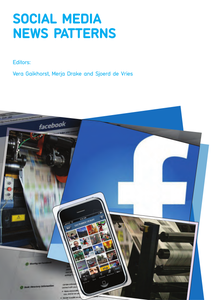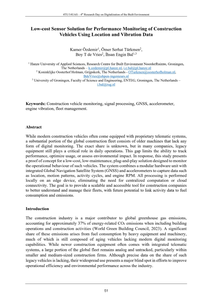Mass-customization challenges the one-size-fits-all assumption of mass production, allowing customers to specify the options that best fit their requirements when choosing a product or a service. In business process management, to achieve mass-customization, providers offer to their customers the opportunity to customize the way in which a process will be enacted. We focus on monitoring as a specific customization aspect. We propose a multidimensional classification of modeling patterns for customized monitoring infrastructures. Patterns enable the provider to offer a set of customizable options to customers and design a monitoring infrastructure that fits the preferences specified by customers on such options. An example in the online advertising industry demonstrates how our framework can improve the services currently offered by providers.
DOCUMENT
Many quality aspects of software systems are addressed in the existing literature on software architecture patterns. But the aspect of system administration seems to be a bit overlooked, even though it is an important aspect too. In this work we present three software architecture patterns that, when applied by software architects, support the work of system administrators: PROVIDE AN ADMINISTRATION API, SINGLE FILE LOCATION, and CENTRALIZED SYSTEM LOGGING. PROVIDE AN ADMINISTRATION API should solve problems encountered when trying to automate administration tasks. The SINGLE FILE LOCATION pattern should help system administrators to find the files of an application in one (hierarchical) place. CENTRALIZED SYSTEM LOGGING is useful to prevent coming up with several logging formats and locations. Abstract provided by the authors. Published in PLoP '13: Proceedings of the 20th Conference on Pattern Languages of Programs ACM.
DOCUMENT

Parents who grew up without digital monitoring have a plethora of parental monitoring opportunities at their disposal. While they can engage in surveillance practices to safeguard their children, they also have to balance freedom against control. This research is based on in-depth interviews with eleven early adolescents and eleven parents to investigate everyday negotiations of parental monitoring. Parental monitoring is presented as a form of lateral surveillance because it entails parents engaging in surveillance practices to monitor their children. The results indicate that some parents are motivated to use digital monitoring tools to safeguard and guide their children, while others refrain from surveillance practices to prioritise freedom and trust. The most common forms of surveillance are location tracking and the monitoring of digital behaviour and screen time. Moreover, we provide unique insights into the use of student tracking systems as an impactful form of control. Early adolescents negotiate these parental monitoring practices, with responses ranging from acceptance to active forms of resistance. Some children also monitor their parents, showcasing a reciprocal form of lateral surveillance. In all families, monitoring practices are negotiated in open conversations that also foster digital resilience. This study shows that the concepts of parental monitoring and lateral surveillance fall short in grasping the reciprocal character of monitoring and the power dynamics in parent-child relations. We therefore propose that monitoring practices in families can best be understood as family surveillance, providing a novel concept to understand how surveillance is embedded in contemporary media practices among interconnected family members.
MULTIFILE

With artificial intelligence (AI) systems entering our working and leisure environments with increasing adaptation and learning capabilities, new opportunities arise for developing hybrid (human-AI) intelligence (HI) systems, comprising new ways of collaboration. However, there is not yet a structured way of specifying design solutions of collaboration for hybrid intelligence (HI) systems and there is a lack of best practices shared across application domains. We address this gap by investigating the generalization of specific design solutions into design patterns that can be shared and applied in different contexts. We present a human-centered bottom-up approach for the specification of design solutions and their abstraction into team design patterns. We apply the proposed approach for 4 concrete HI use cases and show the successful extraction of team design patterns that are generalizable, providing re-usable design components across various domains. This work advances previous research on team design patterns and designing applications of HI systems.
MULTIFILE

Continuous monitoring, continuous auditing and continuous assurance are three methods that utilize a high degree of business intelligence and analytics. The increased interest in the three methods has led to multiple studies that analyze each method or a combination of methods from a micro-level. However, limited studies have focused on the perceived usage scenarios of the three methods from a macro level through the eyes of the end-user. In this study, we bridge the gap by identifying the different usage scenarios for each of the methods according to the end-users, the accountants. Data has been collected through a survey, which is analyzed by applying a nominal analysis and a process mining algorithm. Results show that respondents indicated 13 unique usage scenarios, while not one of the three methods is included in all of the 13 scenarios, which illustrates the diversity of opinions in accountancy practice in the Netherlands.
DOCUMENT

Wereldwijd onderzoek: Hoe gebruiken nieuwsmedia social media? Jongeren lezen geen krant meer, ze kijken op hun smartphone die ze altijd bij de hand hebben. Binnen het lectoraat social media en reputatiemanagement van NHL hogeschool te Leeuwarden heeft een groep internationale studenten in 12 landen onderzoek gedaan. Hierbij hebben ze meer dan 150 social media sites bestudeerd van nieuws media. De resultaten maken deel uit van een internationaal onderzoek van NHL Hogeschool en Haaga Helia University. De onderzoeksvraag was: Wat speelt zich af in de nieuwsmedia? Persbureaus kunnen het overzicht gebruiken om hun social media te optimaliseren. En voor ieder die journalistiek een warm hart toedraagt is het interessante informatie over de nieuwsmedia in een overgangssituatie (2nd edition)
DOCUMENT

Movement behaviors, that is, both physical activity and sedentary behavior, are independently associated with health risks. Although both behaviors have been investigated separately in people after stroke, little is known about the combined movement behavior patterns, differences in these patterns between individuals, or the factors associated with these patterns. Therefore, the objectives of this study are (1) to identify movement behavior patterns in people with first-ever stroke discharged to the home setting and (2) to explore factors associated with the identified patterns.
DOCUMENT

Sensor technology is increasingly applied for the purpose of monitoring elderly’s Activities of Daily Living (ADL), a set of activities used by physicians to benchmark physical and cognitive decline. Visualizing deviations in ADL can help medical specialists and nurses to recognize disease symptoms at an early stage. This paper presents possible visualizations for identifying such deviations. These visualizations have been iteratively explored and developed with three different medical specialists to better understand which deviations are relevant according to the different medical specialisms and explore how these deviations should be best presented. The study results suggest that the participants found a monthly bar graph in which activities are represented by colours as the most suitable from the ones presented. Although the visualizations of every ADL was found to be more or less relevant by the different medical specialists, the preference for focusing on specific ADL’s varied from specialist to specialist.
DOCUMENT

While modern construction vehicles often come equipped with proprietary telematic systems, a substantial portion of the global construction fleet consists of older machines that lack any form of digital monitoring. The exact share is unknown, but in many companies, legacy equipment still plays a critical role in daily operations. This gap limits the ability to track performance, optimize usage, or assess environmental impact. In response, this study presents a proof of concept for a low-cost, low-maintenance, plug-and-play solution designed to monitor the operational behaviour of such vehicles. The system combines a modular hardware unit with integrated Global Navigation Satellite System (GNSS) and accelerometers to capture data such as location, motion patterns, activity cycles, and engine RPM. All processing is performed locally on an edge device, eliminating the need for centralized computation or cloud connectivity. The goal is to provide a scalable and accessible tool for construction companies to better understand and manage their fleets, with future potential to link activity data to fuel consumption and emissions.
DOCUMENT

Ambient monitoring systems offer great possibilities for health trend analysis in addition to anomaly detection. Health trend analysis helps care professionals to evaluate someones functional health and direct or evaluate the choice of interventions. This paper presents one case study of a person that was followed with an ambient monitoring system for almost three years and another of a person that was followed for over a year. A simple algorithm is applied to make a location based data representation. This data is visualized for care professionals, and used for inspecting the regularity of the pattern with means of principal component analysis (PCA). This paper provides a set of tools for analyzing longitudinal behavioral data for health assessments. We advocate a standardized data collection procedure, particularly the health metrics that could be used to validate health focused sensor data analyses.
DOCUMENT